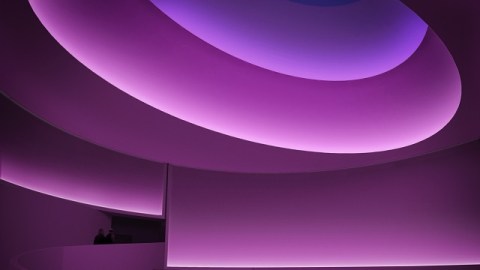Who Is James Turrell and Why Is His Art Suddenly Everywhere?

With strikes in American nerve centers such as New York City, Los Angeles, Houston, and even Las Vegas, one artist this summer is waging a one-man World War Z of retrospective blockbusters. Get ready for “World War T,” led by James Turrell, an artist working in the elusive media of light and space, but who is almost unavoidable this summer by mainstream art audiences after nearly half a century of work. If you don’t know Turrell, you’ll know him by the end of 2013. This multi-venue spotlight on Turrell might finally tune in the spectators Turrell’s so long wanted to see the light.
The idea of using light as artistic expression’s literally as old as the sun. Light’s been shaped into spirituality everywhere from Stonehenge to Chartes Cathedral. When 19th century American artists turned to the breathtaking landscape before them, they focused primarily on how light played on those surfaces and in those skies, taking a page from J.M.W. Turner’s British Romantic playbook. The Luminists, most eminently Frederic Edwin Church, Sanford R. Gifford, and Martin Johnson Heade among them, recognized the coming darkness of the Civil War falling upon the nation and tried to shine a hopeful light, ultimately failing, but spectacularly. (See my thoughts on that spectacular, unavoidable failure as illustrated in the The Metropolitan Museum of Art’s exhibition The Civil War and American Arthere.) Light in the American art tradition’s suffered rough times ever since, culminating in the grifting schlocksmanship of the trademarked “Painter of Light,” Thomas Kinkade.
In the late 1960s, however, as the American counterculture turned back to nature and spirituality, the Light and Space movement emerged with artists such as Robert Irwin, Bruce Nauman, Doug Wheeler, and James Turrell. Simple, non-doctrinal works composed solely of manipulated light and space struck home with the antiauthoritarian spirit of an age looking for soul “food” to fill the emptiness inside. As the 1970s (and beyond) became the age of Warhol and his descendents, however, the business of art as a business overshadowed the Light and Space artists. Perhaps today’s growing modern antiauthoritarian, Occupy environment provides the perfect setting for Light and Space art to see the light of day again.
James Turrell (at the Solomon R. Guggenheim Museum, New York through September 25, 2013), James Turrell: A Retrospective (at the Los Angeles County Museum of Art in Los Angeles through April 6, 2014), and James Turrell: The Light Inside (at the Museum of Fine Arts, Houston through September 22, 2013), as well as Turrell’s Akhob in a Louis Vitton store in a Las Vegas shopping mall, ensure that Turrell’s works will find plenty of light and space this summer and beyond. The pervasiveness and symmetry of Turrell’s invasion of the imagination are impressive, but why him, and why now?
Reading Turrell’s biography, two items stood out to me: his college degree in perceptual psychology and his Quaker upbringing. While studying perceptual psychology, Turrell studied the Ganzfeld effect, the theory that viewing an undifferentiated, uniform field of color can lead to hallucinations, altered states of consciousness, or spiritual experiences (with the descriptor changing most likely depending on your everyday outlook). Put more simply, sit in a darkened room and you’ll start to see things. Or, in Turrell’s world, enter an environment of pure light, such as his Aten Reign light bath for the Guggenheim spiral in New York (see above), and you’ll start to see (and, perhaps, feel) things. Couple that with the Society of Friends’ concept of the inner light within each of us that only requires us to be still and silent enough to hear it, and Turrell’s art seems the perfect antidote to the sensory overload of 21st century life. I’m sure cell phones and iPads will invade Turrell’s space and darken the light, but wouldn’t it be wonderful if more people could just surrender a few moments of their time and just be? Maybe it would be enlightening in the old school sense in helping us reprioritize our Facebook-driven, gotta-answer-this-text existences.
Turrell’s most impressive work, however, won’t be at any of these venues. For the past 30-plus years, Turrell’s worked to transform Roden Crater in Flagstaff, Arizona, from the crater of an extinct volcano into what he calls a “naked eye observatory,” where people would gather to view the heavens free from the light pollution of cities and free of all intermediary technology. Roden Crater’s the pinnacle in Turrell’s series of Skyspaces, but it remains a work in progress with no completion date in sight. As impressive as the Summer of Turrell sounds, it’s important to remember that there’s still a battle between his worldview and the prevailing modern one. Only recently, a towering skyscraper “destroyed” a Turrell Skyspace at the Nasher Sculpture Center in Dallas, Texas, by literally blotting out the slice of sky Turrell envisioned viewers enjoying—an act drenched in symbolism. However, there’s still hope that by this multi-front approach, people will see the light through James Turrell’s eyes and see the light for themselves.
[Image:James Turrell. Rendering for Aten Reign, 2013. Daylight and LED light. Site-specific installation. Solomon R. Guggenheim Museum, New York. © James Turrell. Rendering: Andreas Tjeldflaat, 2012 © Solomon R. Guggenheim Foundation.]
[Many thanks to the Solomon R. Guggenheim Museum, New York, for the image above and other press materials related to their exhibition, James Turrell, which runs through September 25, 2013.]
[ANNOUNCEMENT: I will be presenting a lecture titled “Art Made Personal: Chris Sanderson and the Wyeth Family” at the Christian C. Sanderson Museum in Chadds Ford, PA, on Sunday, June 23rd, from 1 to 3 pm. Please come out to support a great museum with a great collection of art and historical artifacts.]





